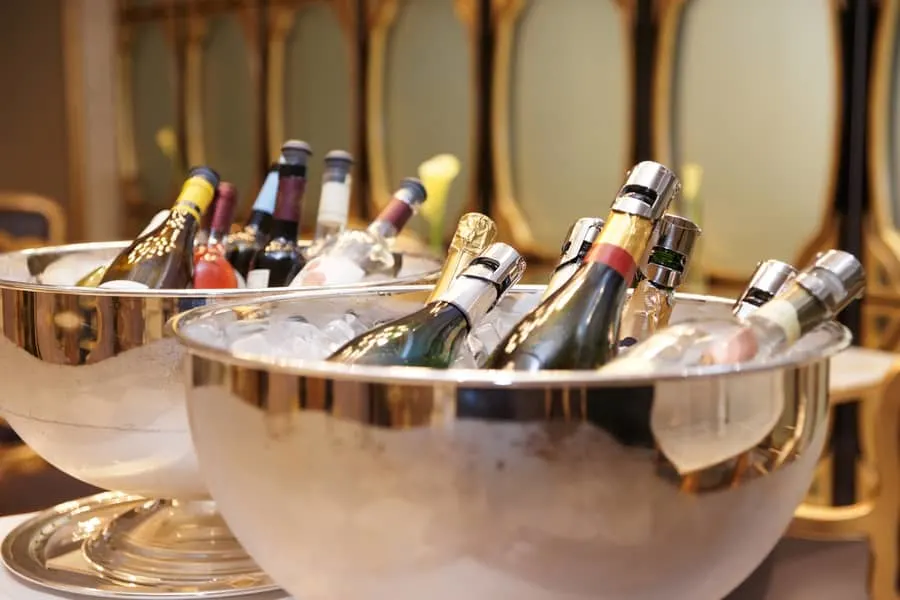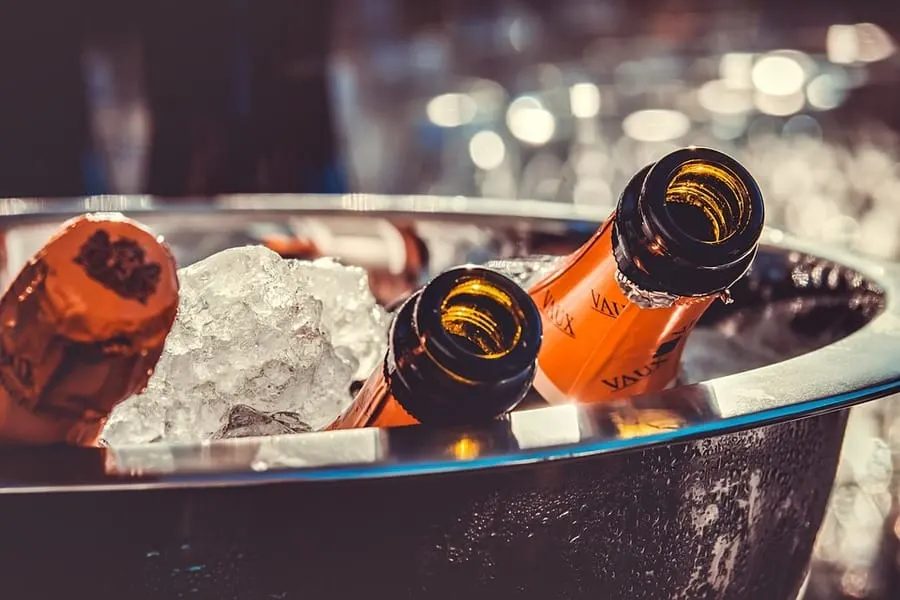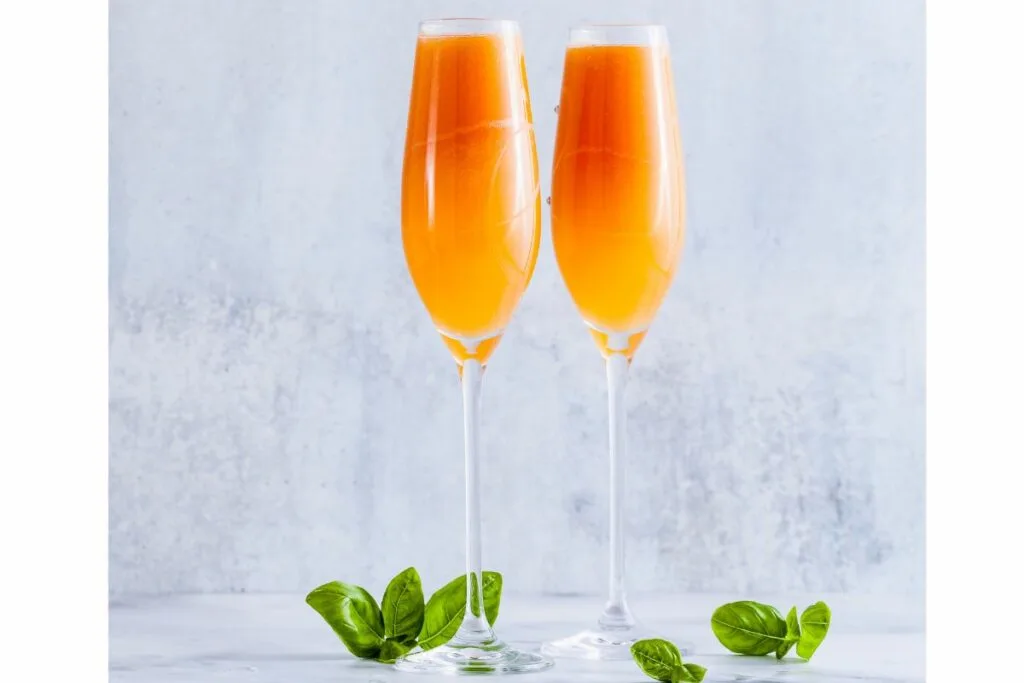As an Amazon Associate, I earn from qualifying purchases with no additional costs for you.
We’ve all tried to chill our Champagne in the kitchen freezer and forget it until the next day. Many people are panicked that their prized bottle of bubbly may not just be ruined but potentially explode all over their frozen food. So is frozen Champagne necessarily ruined?
Champagne will freeze at 15°F to 20°F (-9°C to -6°C) in most freezers set to 0°F but it is not necessarily ruined. Frozen Champagne can be safely thawed and be used for drinking or cooking as long as heat is not applied to expedite thawing.

TIP: If you want to check out the best refrigerator for wine storage, I recommend trying out the Avation (18 bottles) compressor refrigerator with Wi-fi smart app control cooling system. You can find this refrigerator by clicking here (Amazon link).
Is Frozen Champagne Ruined?
Like most alcoholic drinks and all wines, Champagne does freeze if left too long in a standard freezer. The freezing point of most wines, Champagne included, is 15°F to 20°F (-9°C to -6°C), with most household freezers set to 0°F (-18°C) for optimal food safety. Forgotten about long enough in a freezer, Champagne can and will turn into a slushy or even a solid block.
It’s not ideal, but as long as the bottle itself is intact, frozen Champagne is still safe for immediate consumption after thawing.
The crystals that may have fallen out of the wine are perfectly safe to consume; they are tartaric acid crystals, the same as the cream of tartar used when you whip up egg whites into fluffy meringue.
There are a couple of aspects to assessing the damage done to a frozen bottle of Champagne. The first is in evaluating Champagne as a sparkling beverage. Many times, a thawed bottle of Champagne will be significantly less carbonated upon opening.
TIP: If you are interested in learning more about properly storing sparkling wines of all types, read this helpful article. If you want to learn more about wine freezing, check out the interesting results of how long it took my wine to freeze and how it turned out once thawed. Learn what temperature wine freezes in this interesting article.
The other aspect of assessing a frozen and thawed Champagne is its condition as a quality wine. The cold can actually damage some of the more delicate notes of Champagne, not unlike freezer burn. The notes in the wine become more bitter and oxidized, and the fresh fruit and floral notes fade.
Champagne is an incredibly chemically sophisticated beverage, and the extreme cold can alter not only tartrate stability, but also protein stability as well.
Most reputable wine merchants and Champagne houses will not ship wine during the dead of winter, especially if the recipient is located in a cold climate as well.
Recommendation box: Everything you need to enjoy your wine as much as possible. All recommended products are personally tested and regularly used by experts from this website (Amazon links):
> Ivation Wine Cooler – Energy-efficient wine cooler for 18 bottles with Wi-fi smart app control cooling system.
> Wine Rack – Beautiful, elegant wood rack for up to 7 bottles and the choice of vertical or horizontal storage.
> Durand Wine Opener – Classic vintage wine opener (we like all these classic staff).
> YouYah Iceberg Wine Decanter – The most beautiful and handy wine decanter we personally use.
> Bormioli Rocco Wine Glasses – A set of eight elegant and traditional wine glasses made in Italy.
> Vintorio Wine Aerator – Simple but really useful wine aerator for a reasonable price.
> The Original Vacu Vin Wine Saver – The best wine saver on the market in a package with two vacuum stoppers and two wine servers.
And if you want to become a true connoisseur of wine, we recommend reading the book Wine Folly: The Essential Guide to Wine (Amazon link), where you will find all the information you need about winemaking, wine varieties, flavors, and much more.
Should You Chill Champagne in the Freezer? Is There a Better Alternative?
The freezer actually isn’t even the fastest way to get a bottle of Champagne down to serving temperature (about 40-50°F–any colder than that, the flavors of Champagne become hard to taste). It takes about 15 minutes to get Champagne to that temperature in the freezer, which relies on cold circulating air, and that’s if it’s not forgotten in there.
TIP: Most wines go bad once you pop the cork within a day or so. But a Coravin Wine Preservation system (available for a great price on Amazon) can extend the life of your opened wine for weeks or even months. It is awesome. You should check it out to see if it fits your lifestyle.
Due to thermal conductivity, cold water chills down wine bottles much faster than cold air; the fastest way to chill down a bottle of Champagne is to submerge it in salted ice water. The saltwater ice bath takes less than 10 minutes to chill a full 750 ml bottle of Champagne.
This is the method preferred by service professionals in a pinch during busy dinner service in a restaurant; it’s faster, and there’s no risk of the Champagne getting too cold and freezing up. Many Champagne houses make official branded ice buckets, either for sale or as a gift with purchase.
TIP: If you are interested in storing Champagne properly, these are some of the very best wine refrigerators rated for Champagne. You really should check it out so you know all the facts. Discover the differences between a wine refrigerator and a wine cooler in this article.
Video: How Sparkling Wine is Made Including Champagne
How to Thaw Frozen Wine
The best way to thaw a bottle of Champagne is to take it out of the freezer, set it upright in case the cork seal is compromised, and just leave it alone. We’d recommend leaving it in the fridge if you plan on serving it at the end of the evening, or sitting in a sink if you’re in a hurry.
What we do not recommend under any circumstance is that you apply any type of heat to it. No flames or heating elements, no ovens, no warming drawers, no hot or warm water, no hairdryers, and certainly no microwaves!
The extreme, sudden change in temperature is terrible for the wine, and heating the wine can lead to “cooked” notes in the wine, distorting the overall flavor profile of the wine.
Can Frozen Champagne Bottles Explode?

Chilling Champagne in the freezer might seem like the most convenient option. This might seem especially true when there are other things that demand your attention, like food on the stove and guests to be greeted. But frozen Champagne can present other risks besides wonky carbonation and altered flavor–the bottle might literally explode.
TIP: Do you know why wine bottles are 750ml in the USA and only 700ml in Europe? Read this article to find out! Do wine bottles break easily? This guide explains all you will need to know.
The pressure in a full bottle of unfrozen Champagne is typically about six atmospheres, about twice the pressure in a typical car tire thanks to the carbon dioxide trapped inside the liquid. In freezing, we add to that the pressure of the water content in the Champagne itself expanding.
The total force can shatter the glass, exploding outwards with considerable force. But much more likely, the cap will be compromised and liquid will leak out when the pressure inside is too great.
Is it Okay to Chill and Unchill Champagne?
Repeated chilling and unchilling of Champagne, especially in extreme temperatures such as freezing, is far from ideal for a bottle you may want to hold on to for a while.
However, if it’s only being chilled to serving temperature and back up to room temperature, that shouldn’t have a huge impact on a wine that’s being served soon. It’s all about degrees!
To answer this question, let’s look at a winemaking process called cold stabilization. Cold stabilization is used in winemaking to prevent the tartaric acid crystals mentioned earlier (also known as wine diamonds) from precipitating out of the wine once it’s in the bottle.
The point is to go ahead and create those crystals so it doesn’t happen in the customer’s hands, and then filter them away.
Although these crystals are harmless and even edible, they can look like glass shards and unsettling to the average customer. Further, since wine is a huge export product that travels great distances in sometimes unpredictable conditions, added stability of any kind is a great positive.
The general idea of cold stabilization is to simulate the environment of a wine chilled in the fridge by dropping the temperature of the wine to just above freezing.
It’s kept at that temperature for about two weeks while the winemaker waits for the crystals to form, after which the crystals are removed and the wine is brought back up to room temperature.
TIP: To find out more about the effects of freezing liquids in a bottle and how to safely unfreeze a wine bottle without damaging it, read this article. Can you freeze wine or will you ruin it? Find out here!
However, there are a few downsides to cold stabilization, and reasons as to why it is not practiced on every wine. Some argue that the process of filtering the crystals and particles away strips the wine of much of its character. Some believe that wine should be made in a completely non-interventionist way.
Further, Champagne is legally required to be aged for an extended amount of time on its spent yeast cells. That aging process can, to a degree, prevent the formation of these crystals under normal temperature conditions.
However, the main reason, and the more relevant reason, in this case, is that extremely cold temperatures make wine more prone to premature oxidation, shortening the aging potential and lifespan of the wine.
Over-oxidized Champagne can be unappealingly brown in color, devoid of fruit character, and tired before its time. High-end Champagne is a category of wine that is made to be cellar-aged for years and even decades, and anything that causes premature oxidation (or “premox”) must be steered clear of.
Should you Freeze Leftover Champagne?

Knowing everything we now know about the effects of freezing on Champagne, we might think twice about sticking that bottle in the freezer to chill it down. But what about leftovers (in the near-impossible event that you actually somehow had too much Champagne)?
Frozen Champagne might not be ideal for enjoying in the way the winemaker intended when he began crushing the grapes. But frozen or thawed Champagne is still safe to consume, and it stays that way for a long time in the freezer.
We’d recommend freezing them in ice cube trays for separate blocks of small, equal portions, and then storing the cubes in a plastic zipper bag.
Cubes of frozen Champagne are perfect for those recipes that call for just a splash of white wine since that’s essentially what it turns into when you freeze it in an ice tray.
It works great for deglazing a pan for a butter sauce or for finishing a French onion soup; for recipes that require low, slow cooking at a very steady temperature like risotto, we’d recommend melting the cubes first.
For a quick palate cleanser after the main course, spent Champagne can be transformed into a lovely granita. Thawed Champagne can still find a second life at the home bar.
TIP: A suitable wine glass is the basis for enjoying well-being while drinking your favorite wine variety. Here are our favorite ones (Amazon link):
- Bormioli Rocco Crystal Wine Glasses: A set of eight elegant and traditional wine glasses made in Italy for a reasonable price.
- Riedel VINUM Wine Glasses: Luxury set of two wine glasses suitable for any occasion. We just love them!
- Schott Zwiesel Tritan Crystal Glasses: If you like unusual alternatives, a set of six stemless glasses made of crystal glass.
They can be refrozen into boozy ice pops, shaken into margaritas, or stirred into a sangria. If you have enough frozen Champagne cubes, they can even make for great cocktail options for entertaining or enjoying at home.
Adding fruit juice to a Collins glass filled with Champagne ice cubes is a fun twist on a Bellini or a mimosa. Blitzing those ice cubes with a little liquor, syrup, and bitters in a blender gives you a delicious boozy slushie, perfect for those socially distanced outdoor parties in the age of coronavirus.
TIP: Check out this page for a complete list of wine products and accessories I love. You’ll find my recommendations for wine refrigerators, decanters, and aerators and the best place to buy wine online. Click here to see the complete listing.
